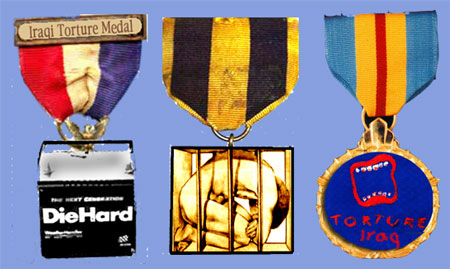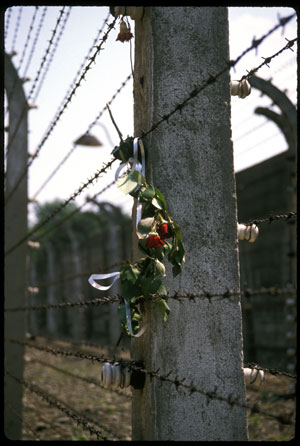
Medals of the Abu Ghriab Brigade
©2004 UrbisMedia
OK, fashioning a set of medals for the abusers and torturers of Iraqi detainees is perhaps a bit of twisted irony. But then the Boosh war on Iraq is nothing if not riddled with ironies. That Americans are occupying their country in the name of freeing Iraqis of the crimes of Saddam Hussein, who used the very same Abu Ghraib prison to torture and murder his countrymen, is ironic. That Americans are putatively in Iraq (forget the phantom WMDs and the mythical Al Qaeda connections) to bring them into the bosom of democracy, and depriving them of the most fundamental of the rights guaranteed by democracies, civil rights, is another layer of irony. That the chickenhawk imbeciles in the administration imagined an Iraqi populace who would welcome our troops as “liberators” and invite us to stay as long as we would like is especially ironic in the light of the latest scandal.
Now I am not trying to imply or equate the malfeasances of Abu Ghraib with those abominations of Hitler and Himler. But unfortunately, we have now shortened this distance in reality and, perceptually, surrendered much of the moral high ground that admittedly we have arrogated to ourselves. But the events of Abu Ghriab did put me in mind of a visit to the world’s most renowned temple of torture that was broadcast 22 years ago.
Out of Auschwitz
Even as we piled into the four cabs that would speed our little group southward out of Warsaw I still had not settled in my mind what in the world it was that so powerfully impelled me toward that awful place. I had three and a half hours on the way, at ninety miles per hour in ninety-degree heat to think more about it. Was it a traveler’s compulsion to see something that was such a deep wound in Poland’s history? Maybe morbid curiosity? Maybe, or something else altogether.
I don’t think I began to close in on the question until I was about to enter the gate four million people had entered but never exited, and read that cynical phrase: Arbeit Macht Frei (Work makes you free). At that moment I realized that I had retained a small corner of doubt that the grim newsreels and photos did not represent something that could “really” have happened. But here was final irrevocable confirmation—Auschwitz was.

©1988, James A. Clapp
And Auschwitz is, in almost every respect, as it was when it was liberated by Soviet troops in 1945. Unlike many of the other extermination camps, the SS, in their zealousness to carry out the “final solution” up to the last minute left itself no opportunity to destroy the evidence of their crimes. Caught by surprise, they unwittingly left behind, along with the few emaciated survivors, the damning and macabre artifacts of the world’s only museum of genocide-the Auschwitz-Birkenau memorial.
As my small group proceeded through the memorial behind our Polish guide there were no superlatives sufficient to convey the wrenching permuted emotions of sadness, disgust and rage. Four million died here, deceived, tortured, stripped of their identity and their dignity. That is why the mute monument is here, because words would not be adequate. That is why the guide drones on and on, almost dispassionately reciting numbers whose magnitudes seem more appropriate for astronomy than social life. That is why we say almost nothing to one another; thoughts will not form into words.
I wondered about the thoughts of the Israeli in yarmulke and prayer shawl when we viewed together a room full of suitcases with Jewish names painted on them. Nearby were large rooms filled several feet high with women’s hair, another is full of shoes, others with spectacles, toothbrushes, even prosthetic limbs, and these only those that had not been shipped out for the Nazi war effort. How many times had these rooms been filled? I wondered what the man in my group who had been scheduled to be moved here from a work camp in France in 1945 was thinking as we looked through the once electrified barbed wire fences on which inmates were once been thrown, or, in despair, threw themselves. What could the elderly Polish man with numbers tattooed on his forearm have been thinking when we stood before the crude gallows made of a length of rail, and the “wall of death” where over twenty thousand were shot in the back of the head.
What were the emotions of the person who found, among the thousands of photos the SS took of their victims, the picture of a relative, only the wilting rose tucked behind the frame indicating that a search among the gaunt faces and terrified eyes had ended. Some of those pictured had names, but most only badges on their striped prison clothes to indicate whether they were Jews, POWs, political prisoners, gypsies, or homosexuals.
As we filed silently into the gas chamber fully clothed and knowing the sunshine awaited us outside I wondered at the last thoughts of the hundreds of thousands who had ignominiously perished in this room, their last glimpse of sunlight coming from the roof ports through which the canisters of Zyklon B rained down on them. We passed though the crematorium, its ovens now bedecked with flowers and burning only with votive candles, and out into the sunlight.
As we sped back to Warsaw after a brief visit to nearby Birkenau my contempt for the perpetrators of Auschwitz was leavened somewhat with the realization that they were not unique. I realized that Auschwitz stands grimly before us today not only as a reminder of its own atrocities, but also those of Armenia, Cambodia, the former Yugoslavia, Uganda, and too many other places. It stands as a reminder of the thin veneer of civilization; that any people capable of regarding others as less human than themselves are capable of re-creating Auschwitz. Auschwitz is not just a place in southern Poland, it’s a concept born of the fusion of prejudice and power; and it can be anywhere.
___________________________________
©1988, ©1989, ©2004, James A. Clapp (UrbisMedia Ltd. Pub. 5.4.2004)
Aired, KPBS-FM, January 23, 1989
